Choosing between a French press and a drip coffee maker isn’t just about brewing preferences—it’s a battle between two distinct worlds of flavor extraction.
While French Press promises deep and rich flavors, the Drip Coffee offers convenience without compromising the taste.
Key Takeaways
- The French press employs an immersion brewing technique where coffee grounds are immersed in hot water, while drip coffee involves water passing through a filter containing coffee grounds.
- French Press produces a rich and full-bodied coffee drink while Drip coffee is Mellow and smooth.
- Drip coffee makers are quick and easy to use while French press requires expertise.
- In French Press, you have full control over the brewing process while Drip machines are generally automatic.
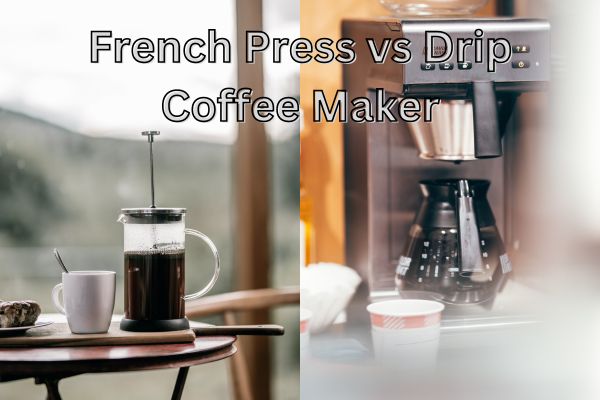
An Overview of French Press Coffee Makers
The French press is an immersion coffee brewing method that involves soaking coarsely ground beans in hot water and pressing the coffee through a metal filter to make a full-bodied and flavorful drink.
So, how does French Press work?
You start by filling the cylindrical French Press Jar with coarse coffee grounds. Then, you pour in hot water and give it a quick stir.
Next, place a lid on top and let the coffee steep for 4-6 minutes. When the brew reaches the desired strength, slowly push down the plunger filter.
And voila! You have a delicious cup of rich coffee ready to be enjoyed.
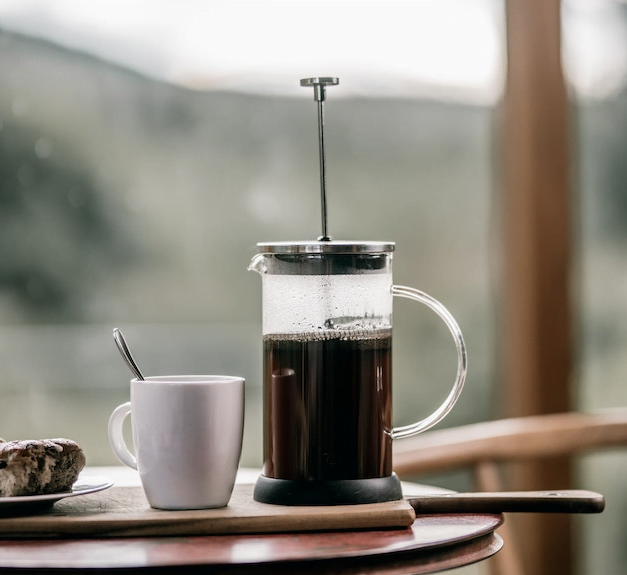
The Pros of French Press Coffee Maker
- You can fine-tune every aspect of brewing with French Press, from the water’s temperature to the grind size and the steeping duration. This freedom allows you to craft a coffee drink that suits your unique palate.
- The French press method extracts rich, bold flavors and natural oils, producing a full-bodied cup of coffee.
- Eco-friendly option – No paper filters required.
- No maintenance required – it’s very simple to clean a French Press. Once you’ve done brewing, just give it a quick rinse, and you’re ready for your next cup
- It’s an excellent option for coffee enthusiasts who want a delicious cup without splurging on expensive equipment
- It’s very lightweight and portable – A perfect device for your traveling adventures.
- Very diverse brewing device – You can make Iced coffee in a French press, brew different varieties of teas, and also froth the milk in it.
Cons of a French Press Coffee Maker
- Less practical for brewing large quantities of coffee at once
- Requires manual effort and attention to detail, which can be a drawback for those seeking a more convenient and effortless coffee-making experience
- Needs an external source to heat the water
- Due to a lack of Paper filters, some fine coffee grounds end up in your coffee (Especially if you don’t know how to use it properly) and some people hate coffee full of sediments.
- May not be a good choice for people with certain health conditions
An Overview of Drip Coffee Makers
Drip Coffee Makers are ideal if you’re looking for a quick and convenient cup of coffee with a decent taste.
Electric drip coffee makers were invented in the 1950s and became a big thing in the US in the 70s – Americans couldn’t get enough of their ease and convenience.
Drip coffee makers can be found in homes, restaurants, and even offices where investing in an espresso machine might not be a priority. Around 33% of Americans use Automatic Drip machines to brew their cup of joe.
Drip coffee makers start with placing a paper filter and coffee grounds in the machine, and then filling the reservoir with water. The water is then heated and slowly dripped through the coffee grounds, extracting their flavors.
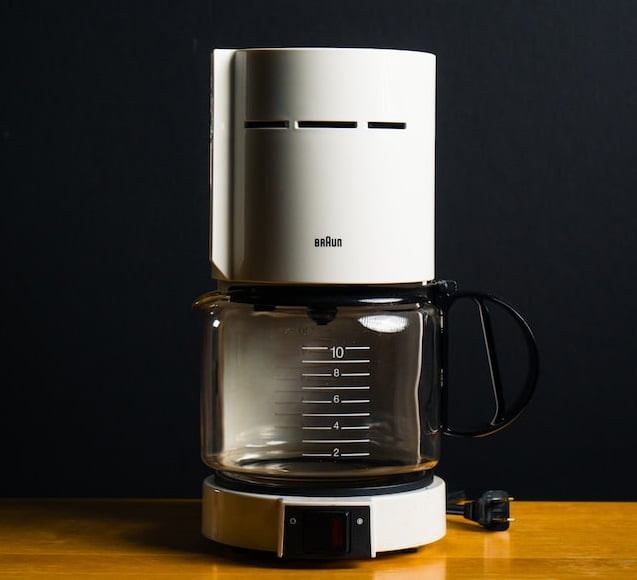
Pros of Drip Coffee Maker
- Coffee prepared in a Drip coffee maker is smooth and less bitter, perfect for those who prefer a mellow drink.
- You can prepare a full pot cup of (up to 12 cups) in drip coffee machines in one go.
- These coffee makers are fully automated, which makes them very easy to use.
- Most Drip Coffee Makers include a programmable function – so you can easily set the timer whenever you want a fresh cup of coffee.
Cons of a Drip Coffee Maker
- Drip Coffee makers are relatively more expensive than French Press
- While paper filters aid in producing a cleaner cup, their ongoing cost and environmental impact can be a drawback
- You don’t have the freedom to control the Brewing parameters like the water temperature and brewing time.
- A drip coffee maker might not satisfy the taste buds of those seeking a stronger coffee drink.
Drip Coffee vs French Press | The Differences
Now let’s compare French Press and Drip Coffee Maker side-by-side
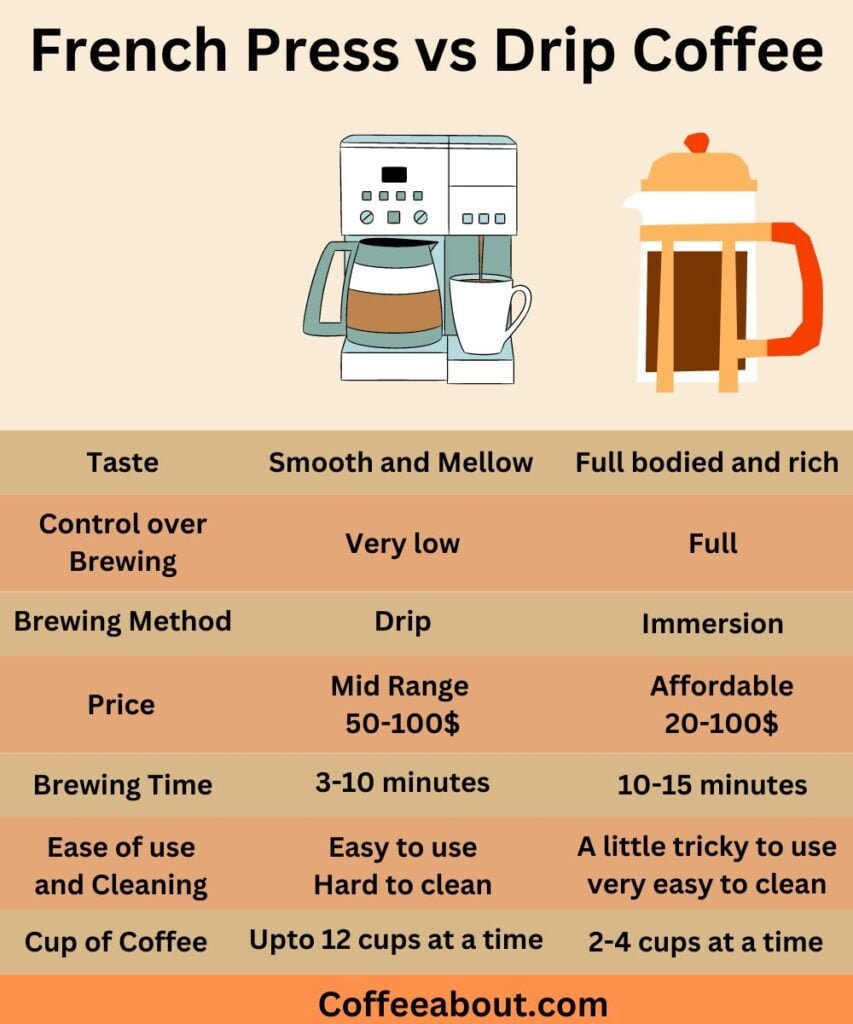
1- The Brewing Method
The brewing method is the main difference between the French press and the Drip Coffee Maker. French press employs an immersion brewing technique, allowing coffee grounds to steep fully in hot water. In Contrast, Drip coffee makers employ the pour-over method, where hot water is passed through coffee grounds suspended in a filter.
French Press requires a coarse grind size and drip coffee machines generally require a medium or medium-fine grind size that you can easily buy in pre-ground forms.
You will require a coffee grinder for French Press as it is difficult to find a perfect coarse pre-ground packet for French Press.
Read a guide on 14 different coffee brewing methods
2- Which Makes the Better Coffee?
French press is definitely better than Drip coffee in terms of taste as it offers a highly flavorful and strong coffee experience, while drip coffee provides a delicate and mellow coffee drink.
The French press actually tastes better and richer due to the presence of natural coffee oils, which are allowed to pass through the metal filter. In contrast, drip coffee makers are equipped with paper filters that effectively capture these oils, resulting in a cleaner drink.
If you are into darker coffee roasts and prefer strong and full-bodied cups of coffee, I recommend you go with a French press. And if you prefer a clean and smooth coffee drink, drip coffee makers will be a better choice.
3- The Brewing Time
Drip Coffee makers are fast compared to French Press. The French Press method involves several steps: boiling, grinding, steeping, plunging, and pouring. This entire process usually takes about 10-15 minutes.
On the other hand, electric drip machines offer a convenient and speedy solution. With just a flick of a switch, these machines do most of the work for you.
While you do have to wait for the machine to heat up and for the coffee to drip down (not as fast as espresso), in general, most drip coffee makers can produce great coffee within 5 to 8 minutes.
Single Serve Pods machines can even brew coffee in as little as 3 minutes.
4- Which One is More Easy to Use and Clean?
French Press is a little difficult to use and requires expertise compared to Drip Coffee Makers. The French press has more variables to consider, such as grind size, brew time, water temperature, and plunging. It takes some practice to achieve perfection in the French press brewing method.
On the other hand, a drip machine is straightforward to use. You simply measure the right amount of coffee, load the machine, fill the reservoir with water, and switch on the machine. It’s hard to go wrong with a drip machine.
In terms of ease of cleaning, Both methods require a similar amount of time for cleanup. With a French press, you simply need to rinse it with water. On the other hand, a drip coffee machine’s pot requires the same rinse, along with disposing of the coffee filter.
However, unlike a drip coffee maker, a French press doesn’t require ongoing maintenance. This is because drip coffee machines have water pumps, heaters, and reservoirs that require maintenance and descaling.
5- The Capacity
In terms of capacity, drip coffee makers have a clear advantage compared to French Press. With a typical drip coffee maker, you can brew up to 12 cups of coffee in a single cycle. While a typical French press is designed to make 2 to 4 cups of coffee, although some large French Presses can brew up to 8 cups.
This generous capacity of drip machines allows you to cater to a larger group or have plenty of coffee available throughout the day.
Another benefit of drip machines is their ability to prepare coffee in advance. You can easily program the machine to prepare a cup of coffee at your desired time.
6- Which is Healthier?
When considering your health, it’s essential to think about cafestol – a compound present in coffee that has been associated with higher levels of bad cholesterol (LDL).
According to McGill University, filtered coffee is generally a better choice in terms of health.
The reason is that filtered coffee eliminates oily compounds like cafestol.
French press coffee doesn’t employ any paper filter, allowing these compounds to end up in your cup.
If you’re keeping an eye on your cholesterol levels, it’s recommended to stick with filtered coffee, even though it may not be as flavorful.
However, if you don’t have any heart or cholesterol problems you can safely consume 2-3 cups of French press coffee in a day
Read a guide on whether French Press is good or bad
7- Reliability and Durability
The French press is certainly more durable and reliable compared to a drip coffee maker due to its simple design without any mechanical parts. With a French press, the worst-case scenario would involve accidentally dropping the glass carafe and causing irreparable damage.
However, even if this happens, replacing a French press is generally affordable.
On the other hand, drip coffee makers are also quite reliable. The main concerns with these machines are potential interruptions in the electricity supply or a broken heating element. These issues can affect the brewing process and impact the quality of your coffee.
Another advantage of the French press is its portability. It can easily accompany you on your travels, allowing you to enjoy a freshly brewed cup of coffee wherever you go.
Final Thoughts
Well, there you have it – the full breakdown of the great French press vs drip coffee debate! As you can see, there are solid cases to be made for both methods.
In the end, brew style preference depends a lot on your priorities.
Some Coffee purists may side with the simple yet flavor-packing French press. Those wanting a fuss-free, reliable cup every single time might stick to their trusty drip maker.
I’d love to hear your take! Comment below if you’re proudly Team Press or Team Drip…or if like me you just refuse to be boxed into one camp and prefer both from time to time!
Read other related comparisons
FAQs
Does French press have more caffeine than drip?
Yes, French press generally has a higher amount of caffeine compared to drip coffee. On average, a cup of French press coffee contains approximately 100-137 mg of caffeine in an 8-ounce serving, while drip coffee typically ranges between 65-120 mg.
However, the amount of caffeine depends mainly on the type of beans you use.
Is it okay to drink French press coffee every day?
Drinking French press coffee in moderation, typically 1 to 3 cups per day, is generally safe for most individuals.
However, if you have a heart condition or take medications that affect blood cholesterol, it is better to drink filtered coffee or use French Press paper filters.
Can you use regular drip coffee in a French press?
Drip Coffee grounds have generally medium or medium-fine grind sizes. While the French Press requires a coarser grind to make a good coffee drink.
So, I want recommend using regular drip coffee in a French Press as it will result in a muddy drink full of sediments.
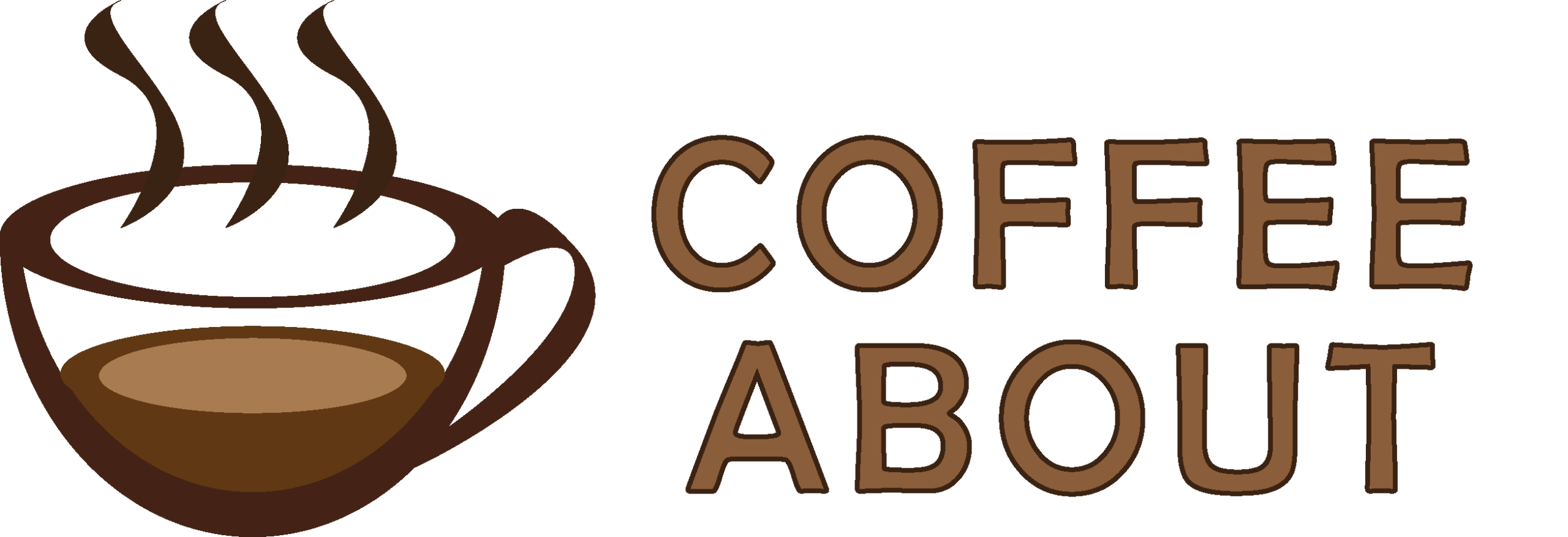
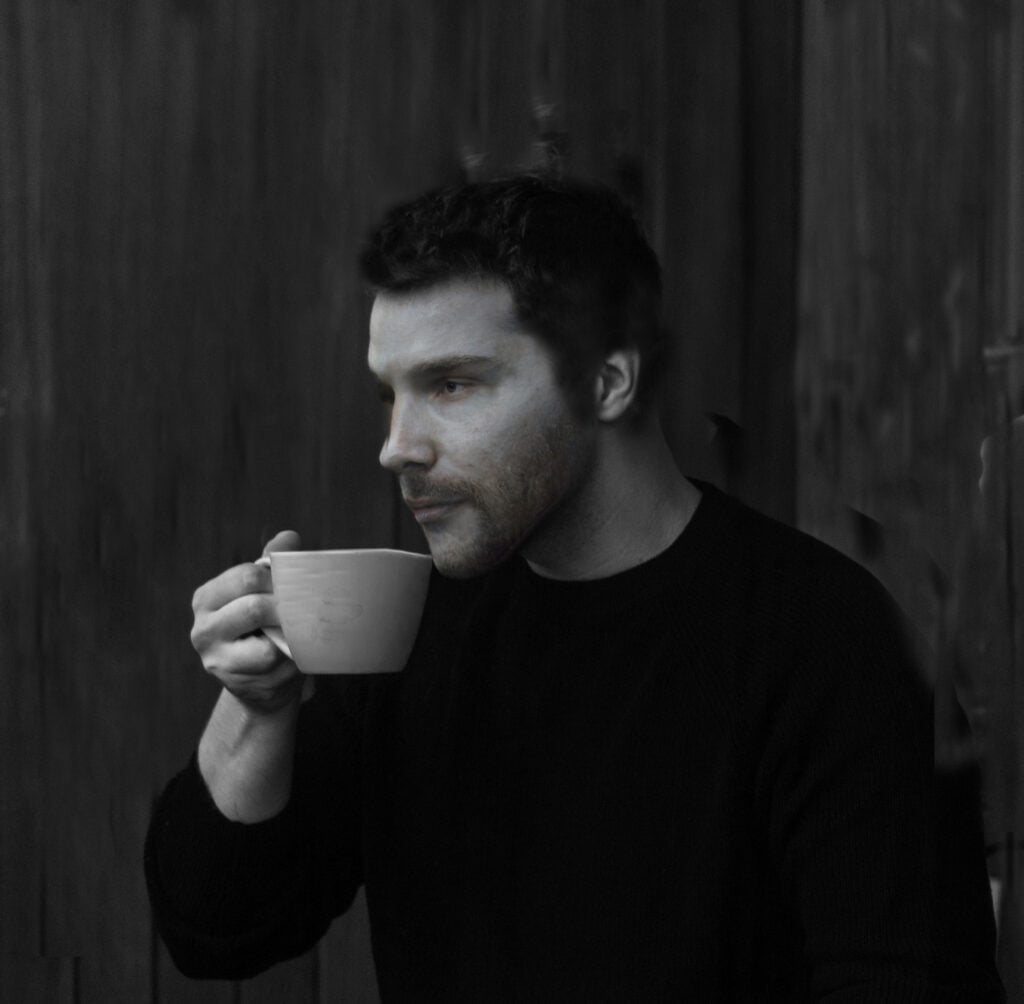


Interesting comparison! I’m a drip coffee person myself. Convenience wins for me. But maybe I’m missing out? French press users, what am I not getting?
You must give it a try if you are a true coffee lover, There is something magical about French Press!